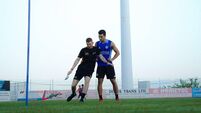‘Lack of navigation skill’ in trawler loss
The Kinsale skipper of the Honeydew II, Ger Bohan, and one of his crew members, Pole Tomasz Jagla, died when the vessel sank off Ram Head in Co Waterford in January 2007. Two other Lithuanian men survived after getting into a liferaft.
The incident happened within hours of the sinking of the Pere Charles trawler with the loss of five lives, also off the south-east coast.
The Marine Casualty Investigation Board (MCIB) carried out a detailed investigation into the sinking, including extensive interviews with the two surviving crew members, Vladimir Kostyr and Viktor Losev.
It was told that the night of the incident had been preceded by a reasonably uneventful day’s fishing.
Shortly after 11pm, Mr Bohan, aged 39, handed over the watch to Vladimir Kostyr, 47, but returned to the wheelhouse on a couple of occasions to take phone calls and speak with the captain of another vessel, the Rachel Jay, on the radio.
“They discussed the weather, which Mr Bohan described as poor, but he was not overly concerned about it,” the report states.
“They also discussed the loss of the Pere Charles, which had sank earlier that evening. The skipper of the Rachel Jay asked would he go into Dunmore East for the night, but Mr Bohan said he would dodge the weather for the night and see what conditions were like in the morning.”
After these calls, Mr Kostyr resumed the watch with instructions to call the captain at 3am or if a target or land appeared within six miles on the radar.
Mr Kostyr kept watch until 2.45am, when he called the captain.
The MCIB report found that during his watch, the bridge watchkeeper (Mr Kostyr) appeared unaware of the actual position of the vessel or the fact it was moving into shallower water.
Mr Bohan got up almost immediately after being called, came into the wheelhouse and looked at the bridge instruments.
Mr Kostyr said there was little or no conversation between them and Mr Bohan simply told him to go down to the cabin to get some rest. Mr Kostyr left the wheelhouse and was descending the stairs between the wheelhouse and the galley/mess room when he felt a powerful impact and the vessel immediately listed to port. They called out to the other two crew members.
Mr Kostyr said he and Mr Jagla got the lifeboat into the water. The other crew member, Mr Losev, said he went briefly to the wheelhouse and that Mr Bohan had the radio in his hand saying “help, help, help”.
A few minutes later, he saw Mr Bohan forced up against the bulkhead by a wall of water, as some of the portside wheelhouse windows started to shatter.
It would appear from the evidence that all crew members, apart from Mr Bohan, made it into the water close to the liferaft, but Mr Jagla was unable to get into it.
It was estimated it only took four minutes from the start of the incident to the vessel capsizing.
In spite of the fact the survivors stated that the skipper attempted to make a radio distress call before the vessel sank, no station received this transmission.
The investigation board concluded that “the effect of the water shoal and prevailing severe weather conditions combined to produce a significantly more treacherous sea condition than had been encountered in the previous hours”.
“The situation was compounded by lack of basic navigation and position plotting skills by the bridge watchkeeper, who appeared unaware of the actual position of the vessel or the fact it was moving into shallower water.
“The primary reason for the loss of the FV Honeydew II is that a wave or waves caused sections of the port bulwark between the stem post and frame five to fail catastrophically and be forced inward. This allowed a large quantity of water to rapidly flood into the shelter deck space. The quantity of water on the shelter deck made capsize inevitable.
“The fact that two crew survived this incident is extraordinary, given the weather conditions and the speed at which the incident unfolded.
“The statements of survivors relating to this incident, being mindful of the trauma and shock they endured, at times appear to be confused and contrary to the actual physical evidence from the wreck.”











